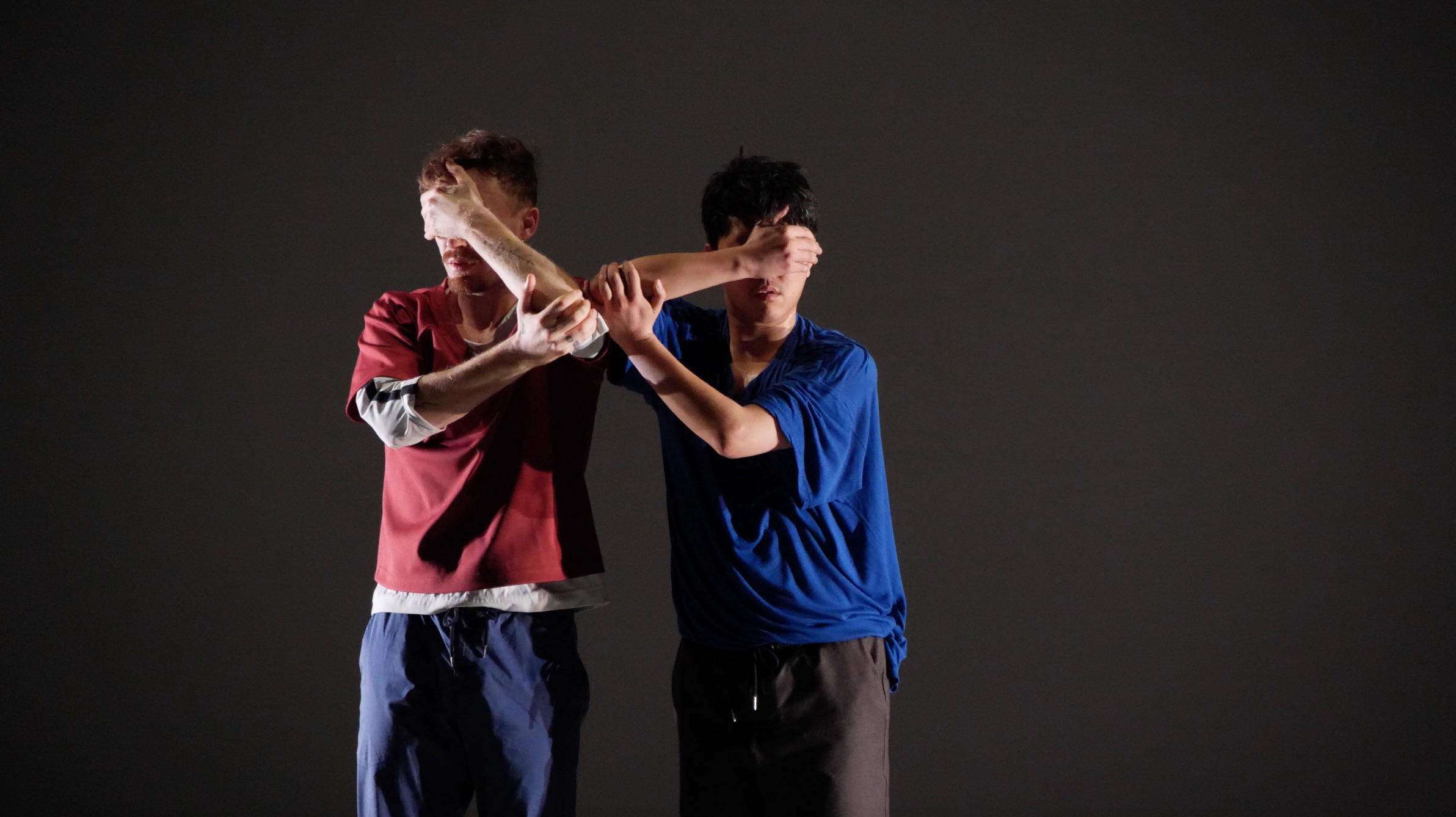Canada at schrit_tmacher justDANCE! 2023
Stuttering bodies
I do not know what it is supposed to mean – In Kerkrade Naishi Wang is presenting together with Lukas Malkowski how complex and ambivalent communication is, where its edges lie and what actually happens when we don’t communicate. In the process, they demonstrate the familiar premise that the latter actually doesn’t work that way at all.
By Rico Stehfest
translated by Karoline Strys
Every humanities and communication scholar is familiar with the name Paul Watzlawik. His axioms of communication theory include the insight that it is impossible for us humans not to communicate. You may assume that the Canadian-based choreographer and performer Naishi Wang might also have had a brief glimpse on this, or even a long one. Yet what he presented together with Lukas Malkowski on the stage of the Kerkrader Theater as part of the schrit_tmacher festival with his work „Face to Face“ is far from being a basic seminar.
Rather, it begins right away with a mirror function and thus makes communication visible in principle. The back wall of the stage shows a video projection through which the audience may perceive itself, so to speak. The gaze falls back into the auditorium but the seats are empty – only two of them are occupied, by the two performers of course. They look into the audience, although they are not actually looking at us. Because the truth is: they are not there. For this piece this is not a triviality. „Face to Face“ means specifically that gaze, representative of all the senses, meaning facing in the sense of presence, if we want to communicate.

Naishi Wang FACE TO FACE©TANZweb.org_Klaus Dilger
Both demonstrate this presence immediately and begin with a simple, intimate embrace. You could almost say: as good as it gets. „Thanks“ to Corona, we now more than appreciate this gesture and its effect. What follows is a separation of the two, which takes place very slowly. Millimeter by millimeter their bodies move away from each other. It takes time until it becomes visible that both keep their eyes closed. Isolated, disconcerting sounds lead the two into an exalted performance that seems to run backwards. Their bodies wind and writhe; the facial expression seems grotesquely exaggerated again and again. Emojis, among other things, have served as inspiration here. These little pictures, which massively simplify emotions, have become representative of a system of exchange that cannot really be reduced to such tiny icons on a screen. Then another embrace, this time quickly resolved. When both perform without visible reference to each other, do they (not) communicate with each other?
Naishi Wang develops isolated sounds with his mouth, as if for a test, and constructs them into rhythm. His counterpart picks up this rhythm and complements it with body percussion. And everything flows into dance, together. There it is, the connection with each other, a clearly perceptible unity of two individuals. And that without recognizable sensory units. This is what the successful implementation of the transmitter-receiver model looks like. Welcome to the center for communication!

Naishi-Wang-FACE-TO-FACE©TANZweb.org_Klaus-Dilger
Central, however, appears still and again and the title refers to it, our face. Not only that our facial expressions are highly complex and can be understood universally, i.e. across cultures. As is well known, we most sensory organs are situated on our heads. And without them, communication looks bleak. The term „accessibility“ says it all.
If it is missing, the face, things become difficult. We know this from telephone calls. That’s why the two performers repeatedly hide their faces, dance facing away from the audience, turned away. An arm in front of the face virtually erases it. Our senses are vulnerable. We have to protect them. When we cry, we intuitively raise our hands in front of our faces. Nevertheless, the person on stage also communicates with it.
But when does this connection interrupt? Naishi Wang and Lukas Malkowski also show this. Another video projection, this time the empty stage is doubled with the white dance floor. After Wang left the stage, he appears in the projection. He starts a performance, which Malkowski is trying to pick up. As he does so, he intones Rick Astley: „Never gonna give you up / Never gonna let you down / Never gonna run around and desert you.“ What is obviously missing at this point is the consensus, because Wang has long since disappeared from the stage, respectively from the video. No shouting helps either.

Naishi-Wang-FACE-TO-FACE©TANZweb.org_Klaus-Dilger
In the course of the evening, both also repeatedly freeze in the middle of their movements and remain motionless for a long time. This raises the question to what extent they stop communicating. Is it possible to stop contents that are supposed to be transported? This playful reflection is fundamental to dance as a means of communication. And here, too, it is true that, if at all, communication can succeed at best for a moment. And one can only wish for that. But it cannot be forced. The attempt makes wise. It is well known that it is worth it. And afterwards, you can go separate ways again. Just like Wang and Malkowski did in the end.

Naishi Wang FACE TO FACE©TANZweb.org_Klaus Dilger











